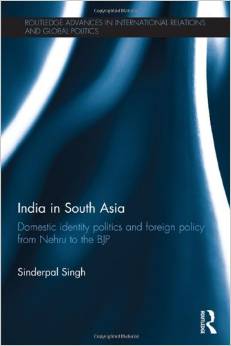India in South Asia: Domestic Identity Politics and Foreign Policy from Nehru to the BJP

Indian foreign policy is often described as having shed its ‘postcolonial baggage’, having had a moralistic ‘chip on its shoulder’ after its independence. Happily though, India has now become ‘more realist’or more based on ‘liberal values’(depending on an author’s perspective). These narratives of Indian history suggest that India’s postcolonial identity inhibited its pursuit of a sensible, understandable, ‘realist’ or ‘liberal’ foreign policy: a ‘problem’ that has long since been overcome. It is to this state of affairs that Sinderpal Singh’s India in South Asia intervenes.
Singh examines three periods of Indian history and three domestic issues of Indian identity. This is arranged by periods of leadership, considering Prime Ministers Jawaharlal Nehru (1947-1964), Indira Gandhi (1966-1977, 1980-1984) and Atal Bihari Vajpayee (1998-2004) and the roles played by competing visions of secularism, democracy and anti-imperialism in India’s regional relations. His work shows that the roots of India-Pakistan tension lie not in an inherent rivalry but in the identity politics of post-partition South Asia and the afterlives of the ‘two-nation theory’. Indira Gandhi, so often considered an archetype of ruthless realism, is portrayed as continuing India’s anti-imperialist identity while negotiating difficult regional issues with Sri Lanka and Pakistan. Under Vajpayee, the BJP renegotiated this anti-imperialist identity as based on Hindu-centered visions of India’s national and civilizational honour. This played out in India’s relations with Bangladesh and Pakistan which Singh examines in the context of the Kargil conflict and cross-border migrations of Bangladeshis, who were portrayed as ‘Islamic terrorists’ and ‘illegal migrants’.
This study provides an important new vision of Indian foreign policy in the context of its domestic identity politics. There are, however, some limitations. Singh has not done any new empirical or archival research, save for some contemporary interviews, basing his research primarily on an impressive and detailed array of publicly available documents. In terms of other recent studies, he does not quite match the theoretical inquisitiveness of Chacko or the empirical vigour of Bhagavan. And yet, in the field of Indian foreign policy it is not strictly necessary to do such things to make an important new contribution to the field. Singh does not need a retelling or rethinking of constructivism simply because this theory has yet to be thoroughly applied. The limitation of analysis to India’s leaders, as opposed to its lesser-known diplomats, is something that needs to be overcome in future studies of Indian foreign policy. Still, India in South Asia is an important addition to our understanding of Indian identity and foreign policy. Singh skilfully and rigorously makes the case that India’s domestic identity politics shapes its regional relationships. While there remains much more work to be done, our understanding of Indian foreign policy is all the better for this book.
Dr. Sinderpal Singh, India in South Asia: Domestic Identity Politics and Foreign Policy from Nehru to the BJP (New York & Abingdon: Routledge, 2013)
Reviewed by Alexander E. Davis, Ph.D. candidate at the University of Adelaide





